ALMA NRAO News April 2006
ALMA News from the April 2006 Issue of the NRAO Newsletter
ATACAMA LARGE MILLIMETER ARRAY
ALMA Construction
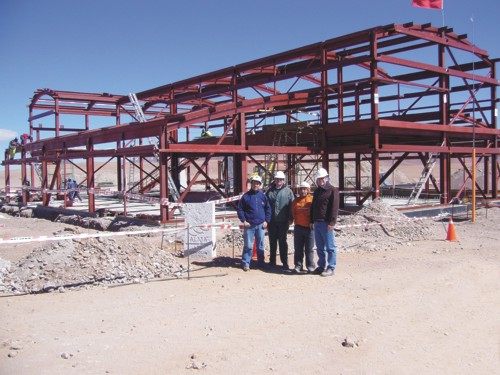 |
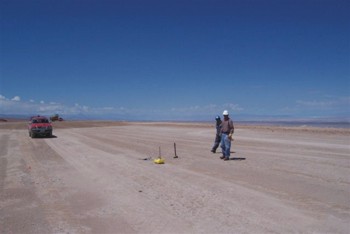 |
| Figure 1. The technical building at
the 16,000 foot Array Operations Site took shape over the austral
summer. Left-to-right: Eduardo Donoso (NA Site IPT lead), Bill
Porter (NA Deputy Project Manager), Andres Zumaeta (Con-Pax
Construction), and Jeff Zivick (NA Antenna IPT lead). |
Figure 2. Vertex will assemble its ALMA antennas at the Operations Support Facility antenna laydown area, which was levelled in preparation for construction of that facility by Vertex. |
The area where Vertex will conduct its on-site antenna erection and testing has been graded. This site is located at the Eastern edge of the Operations Support Facility (OSF) area. The vendor is expected to begin development of the site shortly. The Vertex antenna acquisition continues toward delivery of the first antenna to Chile late in 2006. During February, a Preliminary Pre-Production Design Review was held to track progress and identify issues for resolution.
Before a quorum of the production antennas arrive in Chile, the prototype ALMA system is being assembled into a one-baseline interferometer using the remaining two prototype antennas at the ALMA Test Facility (ATF) in New Mexico. The Mitsubishi prototype antenna has been disassembled for return to Osaka, Japan retrofit to production designs.
At the ALMA Prototype System Integration group in Socorro, Peter Napier has assumed his new role as Team Leader. After final lab tests, the system now being measured in the New Mexico Array Operations Center (AOC) labs will be reassembled at the ATF for astronomical testing, which will commence in the fall. In early 2008, this process will be repeated at the OSF in Chile as production antennas become available.
The ATF site lacks the atmospheric clarity needed for some ALMA component tests, including the water vapor radiometers (WVRs), which operate at the atmospherically difficult 183 GHz water line. Therefore, tests of the two prototype WVRs are occurring on the Submillimeter Array on Mauna Kea. These tests should provide the confidence needed to let the production contracts for these systems.
As the last NRAO Newsletter was going to press, ESO had just signed (December 6, 2005) a contract with Alcatel Alenia Space to supply twenty-five antennas for the ALMA project. This was followed just before Christmas by the signing of a contract with Scheuerle Fahrzeugfabrik to supply two special vehicles for the transport of the radio antennas. These vehicles must lift the 110 ton antenna systems and transport them over the ALMA road, often for several tens of kilometers, to and from the antenna stations and the OSF. To do this, these vehicles are equipped with twin 1340 horsepower engines; the transporters measure 33 feet wide, 52 feet long, and 15 feet high.
As a result of the decision that ALMA would procure substantial numbers of antennas of differing design, the newly rebaselined budget, reviewed by an external panel last October, was further modified. This updated budget was then reviewed by a subset of the same panel which had met in October. This Delta Cost Review was held January 25 at the National Science Foundation. The performance of the production antennas can be predicted as a result of the tests performed to validate the specifications of the prototype antennas. At the NSF review, the Project Scientists reported that the effect of the two designs on ALMA science was minimal and that there may in fact be some benefits owing to the strict specifications on the production antennas.
During the week following the Delta Cost Review, a review of the ALMA North America Cost and Management was held in Charlottesville, Virginia. The review committee, composed of external experts, was chaired by Donald Hartill of Cornell. The report of this committee was to be delivered to NSF by the end of February.
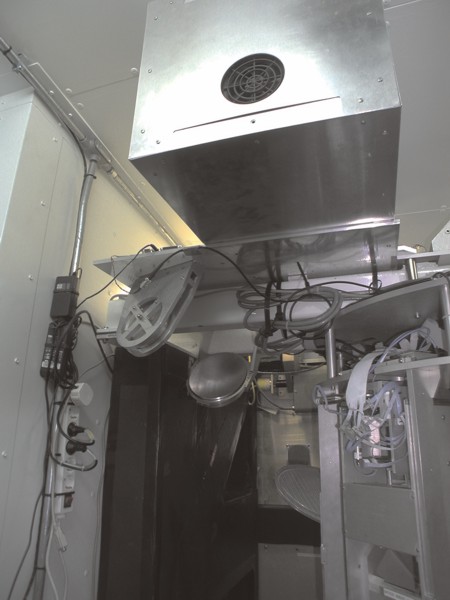 |
Figure 3. ALMA
prototype Water Vapor atmospherically Radiometer installed on an antenna of the Submillimeter Array. |
| Figure 4. At the ALMA Test Facility, the Mitsubishi prototype antenna was disassembled for shipment to Japan, retrofitting to production specifications, and delivery to the ALMA site. | 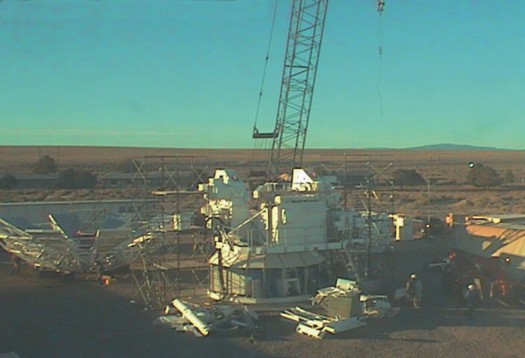 |
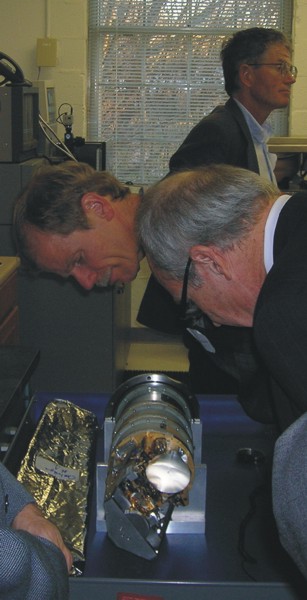 |
Figure 5. Michael Turner, NSF Asst. Director for Math and Physical Sciences, examines an ALMA 1.3 mm receiver cartridge with Review committee member Neal Erickson (Univerity of Massachusetts). |
The President's FY2007 budget was delivered on February 7. On March 2, 2006, NSF Director Arden Bement provided testimony on the agency's $6.02 billion budget request to the House Appropriations Subcommittee on Science, the Departments of State, Justice, and Commerce and Related Agencies. The Administration's request would increase NSF's budget by $439 million, or 7.9 percent, over FY 2006. The increase is part of the President's American Competitiveness Initiative, which includes a commitment to double NSF's budget over the next ten years. At the hearing, Dr. Bement noted that "providing world-class facilities and infrastructure" is a top 2007 priority. "NSF has a long-established role in providing state-of-the-art infrastructure to meet major research challenges. Our strategy is to invest in tools that promise significant advances in a field of research and to make them widely available to a broad cross-section of investigators. Total funding in the Major Research Equipment and Facilities Construction (MREFC) account is proposed at $240.45 million." ALMA is one of five ongoing MREFC projects. In questions later, Bement identified ALMA as a transformational instrument. Details on the ALMA budget may be found at the NSF FY2007 budget website. $47,890,000 is requested for ALMA Construction. As may be seen in the ALMA Funding Profile Table, ALMA Operations and Maintenance funds are for the first time a major component of the FY2007 budget.
North American ALMA Science Center
We are currently conducting an internal search for a full-time Head of the NAASC and expect to fill the post soon. In the interim, Adrian Russell, the NA ALMA Project Manager, has assumed the role of Acting Head of the NAASC, and John Hibbard has assumed the role of Acting Head of the NA ALMA Regional Center, a subset of the NAASC with responsibilities for the core ALMA Operations functions in North America.
We have also recently welcomed Crystal Brogan into the NAASC. Crystal joined the NRAO scientific staff on March 6, 2006 having arrvied from Hawaii, where she was the JCMT Fellow at the Institute for Astronomy in Hilo. Crystal is familiar to all of us at NRAO, having been a Jansky Fellow in Socorro from 2000-2003. Prior to that Crystal obtained her Ph.D. in astronomy from the University of Kentucky under the guidance of Tom Troland. She brings to the NAASC expertise on sub-millimeter imaging and spectroscopy, imaging of galactic star forming regions, the structure of the ISM and magnetic fields, as well as familiarity with the ALMA offline reduction software through her prior role with the NRAO AIPS++ Users Group.
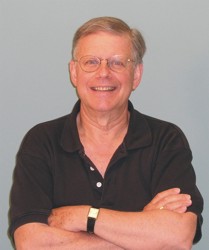 |
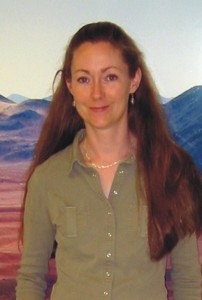 |
| Paul Vanden Bout | Crystal Brogan |
In keeping with the changing cast of characters involved with the NAASC, we have invited representatives from the National Research Council of Canada Herzberg Institute of Astrophysics (NRC-HIA) to our monthly NAASC organizational meeting. James Di Francesco has been designated as the official NRC-HIA liaison. Additional meetings are planned over the coming months to incorporate Canadian input into NA ALMA operations.
The NAASC staff continues to make progress preparing for ALMA's operational phase, including work on the organizational and staffing plan and participation in tests of critical ALMA elements, such as the proposal tool, the pipeline system, and the off-line data reduction software. Key tests are planned in this area in early 2006, as is a comprehensive internal review of the NAASC Operations Plan. Progress also continues on developing spectral line and calibrator databases for use with the ALMA observing tool. We are also busy planning for several meetings, including a special session at the June AAS meeting in Calgary Canada (see accompanying article), the IAU in Prague in August, and the ALMA Madrid meeting in November. More information on the NAASC is available at http://www.cv.nrao.edu/naasc/.
ALMA North American Science Advisory Committee
The ALMA North American Science Advisory Committee (ANASAC) is composed of representatives of the wider North American astronomical community who provide scientific advice to the NRAO Director on the operation of the NAASC. The ANASAC met via telecon on February 24, 2006. The February meeting marked the end of the three year terms for five ANASAC members: Dick Crutcher (U. Ill.), Jason Glenn (U. Col.), Mark Gurwell (CfA, Harvard), Joan Najita (NOAO), and Min Yun (U. Mass). We thank these members for their invaluable input regarding ALMA. We are especially indebted to Dick Crutcher and Min Yun for their service and leadership as past ANASAC Chairs. Several new members have joined the ANASAC: Todd Clancy (SSI), Kelsey Johnson (UVa), Terry Herter (Cornell), Alycia Weinberger (OCIW-DTM); and Chris Carilli (NRAO) was appointed for an additional three-year term.Topics discussed at the monthly ANASAC telecon include the results of the recent ALMA reviews, the current ASAC charges, future NAASC workshops, and a possible grants program to support work demonstrating the science goals of ALMA. The next ANASAC telecon is scheduled for April 28, 2006 where further discussion of future NAASC workshops and the grants program are planned. A listing of the current ANASAC membership and meeting schedule are given at www.cv.nrao.edu/naasc/admin.shtml. The community is encouraged to contact their ANASAC representatives with any ideas or questions on NA ALMA operations or the Science Center.
NAASC ALMA Workshop: "From z-Machines to ALMA: (Sub)millime- ter Spectroscopy of Galaxies"
On January 13-14, Charlottesville welcomed 75 scientists from 37 institutions in nine different countries to the first NRAO North American Science Center Workshop, "From z-Machines to ALMA: (Sub)mil-limeter Spectroscopy of Galaxies". In 26 oral and 23 poster presentations, the participants assessed the technical challenges and scientific promise of using wide-bandwidth spectroscopy to study distant, dusty galaxy populations. The first day closed with a reception sponsored by the NRAO Director, while the second ended with a freewheeling discussion of the role played by current NRAO facilities in this exciting scientific area, plus a view of the future provided by North American ALMA Project Director Adrian Russell. Proceedings for the workshop will be published by the Astronomical Society of the Pacific in 2006. The meeting program, electronic versions of the presentations, the conference photograph, and candid pictures of participants are available at http://www.cv.nrao.edu/naasc/zmachines/.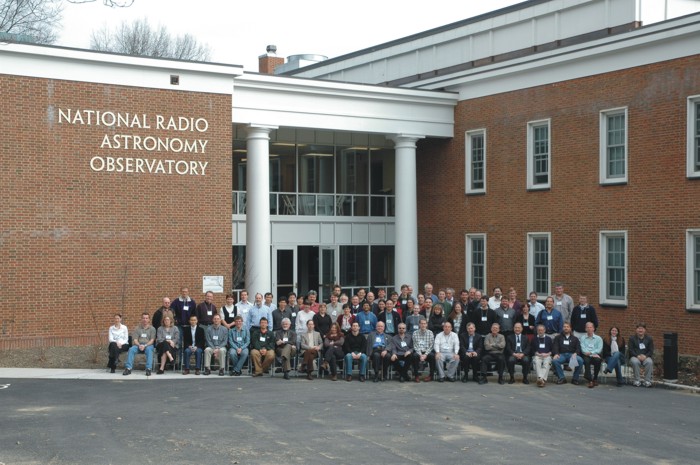
As chairs of the scientific and local organizing D.C. The Town Meeting was held on Monday, committees, we were delighted by the community's January 9 from 12:30 to 1:30 p.m. in the Cotillion enthusiasm for the workshop - the NRAO auditorium Ballroom and was attended by over 200 AAS members. was at full capacity! - and by the participants' clear enjoyment. A great deal of the credit for this success goes to the Scientific Organizing Committee and Local Organizing Committee, notably Laurie Clark and Jennifer Neighbours. We hope this will be merely the first of many NAASC workshops on ALMA-related themes. Suggestions from the community for future events are welcome.
ALMA Town Meeting at January AAS Meeting
| The NRAO Director, Fred K.Y. Lo, kicked off the meeting with a welcome and introduction, followed by a dynamic presentation by the North American ALMA Project Manager, Adrian Russell. This included a list of the impressive accomplishments achieved by ALMA over the past year, as well as current pictures of the on-going construction at the ALMA sites in Chile. Chris Carilli gave a presentation on the main science goals of ALMA, and Crystal Brogan described the plans for the North American ALMA Science Center. These presentations were followed by 30 minutes of discussion. All of the above presentations are available at http://www.cv.nrao.edu/naasc/TownMeetings/. After the meeting, members of the ANASAC joined Fred Lo and NRAO staff members for a lunch to discuss the ALMA project, the science center, and the NA community. | 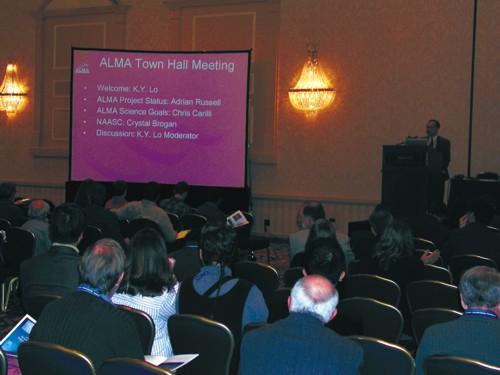 |
| NRAO Director Fred K. Y. Lo speaks at the ALMA Town Meeting |
J. E. Hibbard and A. H. Wootten
ALMA Special Session at Calgary AAS Meeting:
"Imaging Star Formation in the Cosmos with ALMA"
The Atacama Large Millimeter Array (ALMA) will provide quantum leaps in improvement compared to existing facilities, enabling entirely new science at millimeter and submillimeter wavelengths. Star formation in the Milky Way will be revealed with a hundred-fold increase in sensitivity and resolution, making it possible to see evidence of protoplanets in protostellar disks and to measure disk chemical differentiation. Star-forming molecular gas in nearby galaxies will be imaged with high sensitivity at parsec-scale resolution, providing new insight into the structure and evolution of galaxies. Multiple transitions of molecular and atomic gas will be imaged in distant galaxies back to the era of recombination, providing information on the chemistry, structure, formation, and evolution of the earliest galaxies.The North American ALMA Science Center (NAASC) is sponsoring a special session at the 208th meeting of the American Astronomical Society, to be held June 4-8, 2006 in Calgary, Alberta, Canada. The special session will take place from 2:30-4:00pm on Monday June 5, in order to adjoin the meeting of the Canadian Astronomical Society (CASCA). It will feature review talks highlighting ALMA's capabilities and scientific potential in three key research areas:
Doug Johnstone (NRC-HIA): Star formation in our galaxy: the need for ALMA
Jean L. Turner (UCLA): Imaging star-forming gas in nearby galaxies
Andrew W. Blain (Caltech): Imaging high-z starburst galaxies
We invite AAS attendees to present relevant poster contributions to this session by selecting it when submitting their abstracts. The deadline for abstract submission is March 23, 2006 via the AAS website http://www.aas.org/meetings/aas208/.




Connect with NRAO